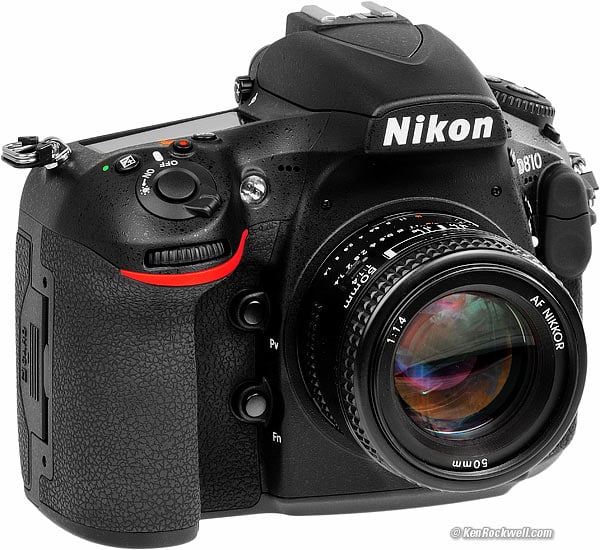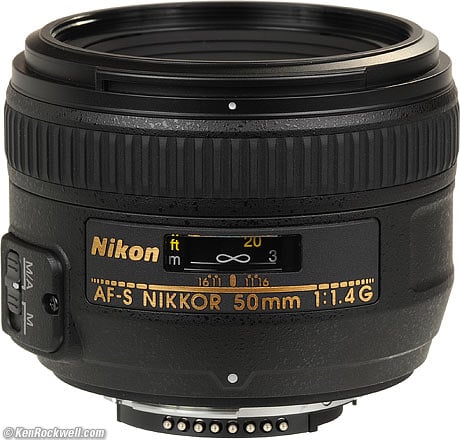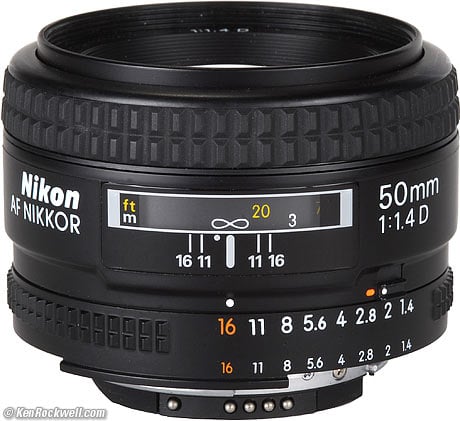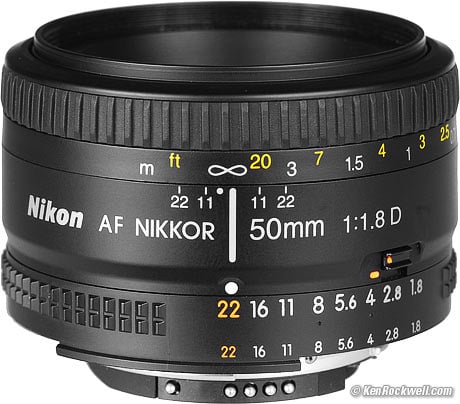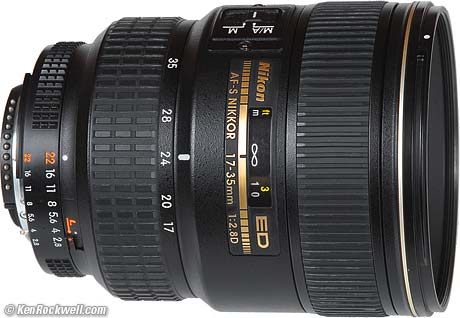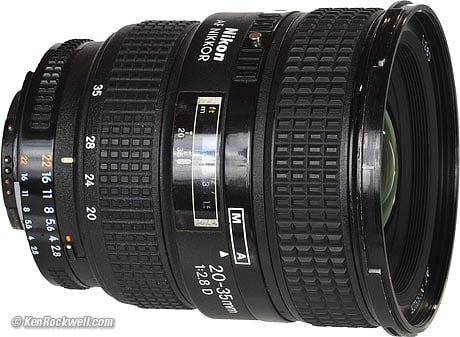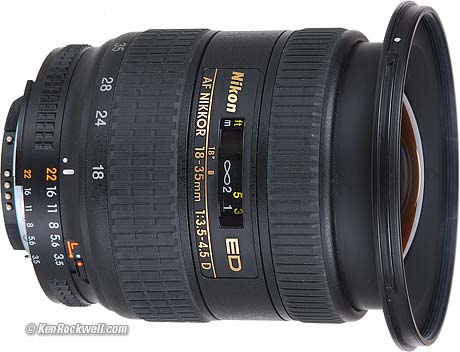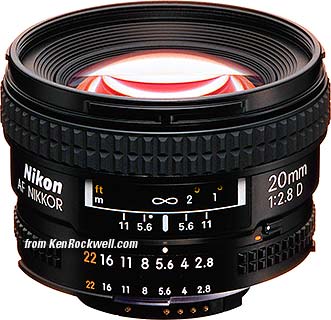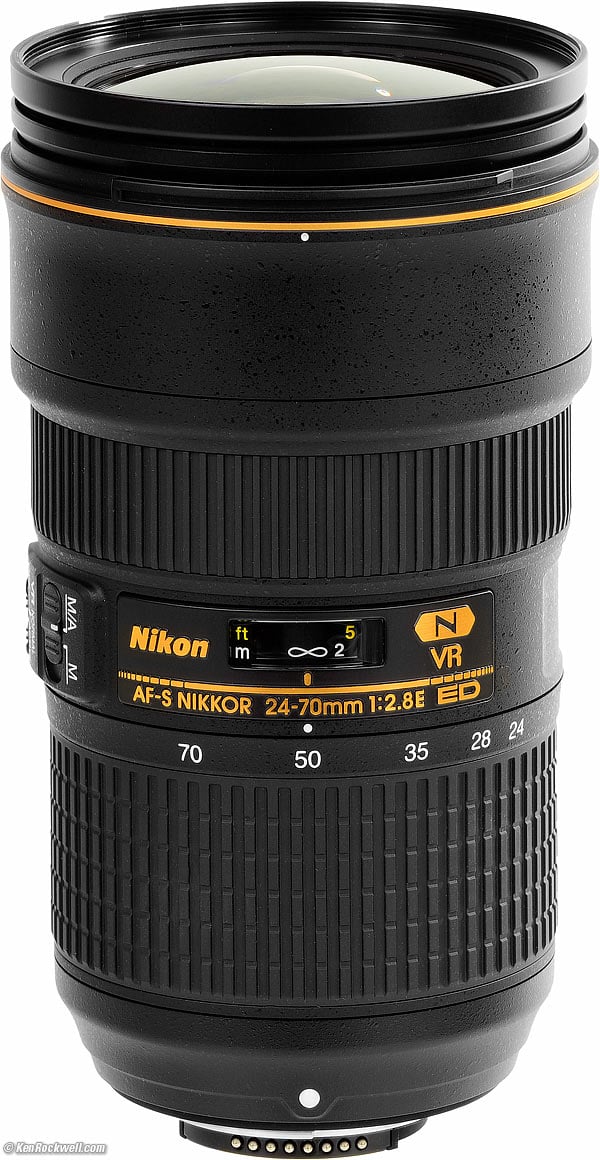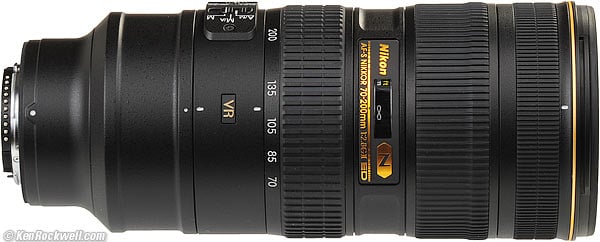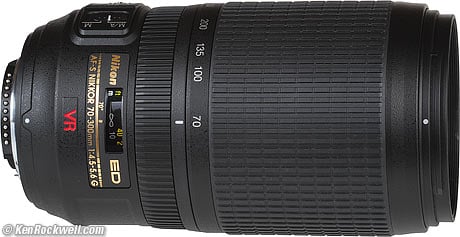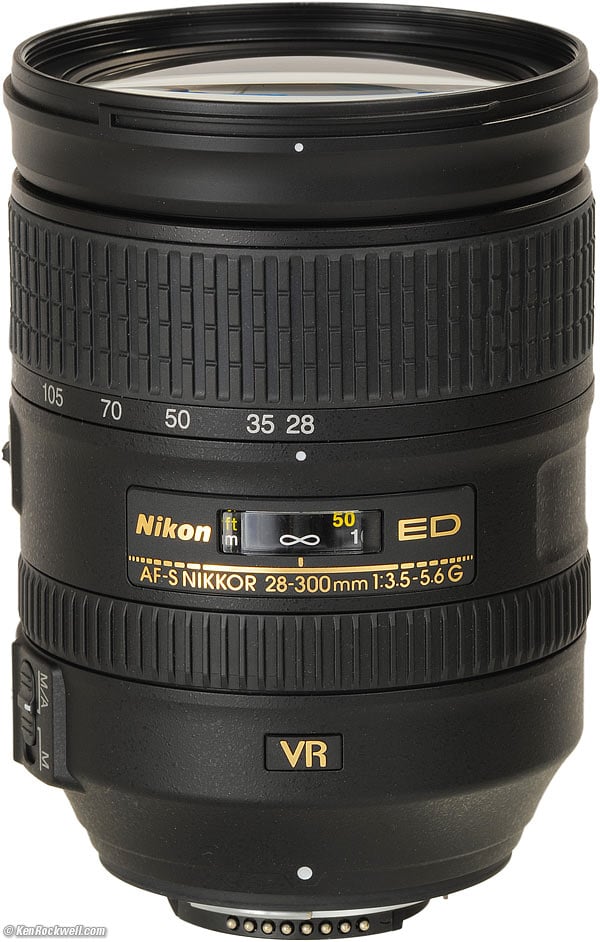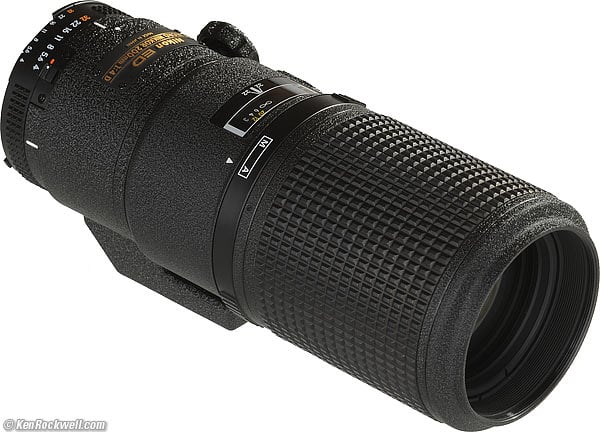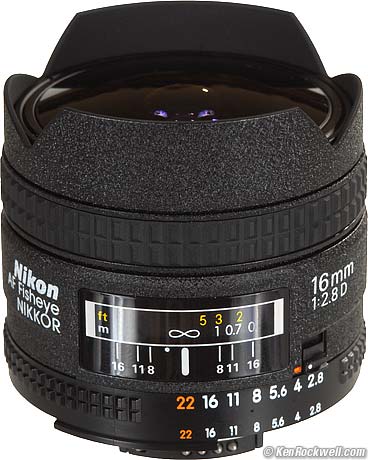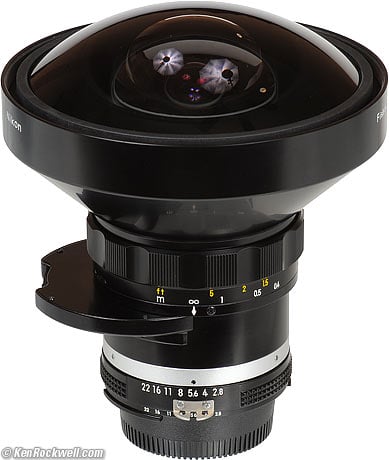Home Donate New Search Gallery Reviews How-To Books Links Workshops About Contact
Nikon Lenses for FX and 35mm Cameras
DX Normal Tele Wide Midrange Universal
Portrait Macro Fisheye Manual Inexpensive
Nikon D810 with 50mm f/1.4D.
This all-content, junk-free website's biggest source of support is when you use any of these links to my personally-approved sources when you get anything, regardless of the country in which you live. Nikon does not seal its boxes in any way, so never buy at retail or any other source not on my personally approved list since you'll have no way of knowing if you're missing accessories, getting a defective, damaged, returned, store demo or used camera. Buy only from the approved sources I use myself for the best prices, service, return policies and selection. Thanks for helping me help you! Ken.
January 2016 Nikon Reviews Nikon Lenses All Reviews
See also:
The Nikon FX Dream Team (Nikon's very best)
Nikon FX Lens Suggestions (includes older lenses)
Nikon Cheapskate FX Lenses (great performance, cheap)
The DX Dream Team (for DX cameras)
|
I buy only from these approved sources. I can't vouch for ads below. |
How Much to Spend?
It is far better to spend money on lenses than on digital camera bodies.
Whatever lenses you buy today will last you for many new cameras to come.
For instance, I bought my 17-35mm back for use on my F100 film camera in April 2000, and it's still Nikon's toughest and fastest ultrawide zoom today.
See Lens or Camera and Is It Worth It.
Unlike camera bodies, the best of these lenses actually appreciate in value over time.
The Nikon 17-35mm I bought in 2000 sells used today for exactly what I paid for it new.
The Nikon 80-200mm f/2.8 AF-S I bought new in 1999 sells used today for more than I paid for it.
The Nikon 28mm f/1.4 sells used today for four times what I paid for it.
Buy the best and you'll make money, and better, all these lenses are still Nikon's state-of-the-art for Nikon FX cameras.
Be very careful about what you spend on camera bodies, but never deny yourself the lenses you deserve.
Forget DX Lenses top
If you already own DX lenses, FX cameras will automatically degrade themselves only to use the center part of their sensors and viewfinders, but you'll quickly tire of them and buy real FX lenses anyway.
Don't buy DX lenses for FX cameras.
DX lenses use only the central DX portion of the FX sensor and viewfinder. That's not why you bought an FX cameras.
See crop factor if this isn't making sense.
If you have a DX camera, see The DX Dream Team.
Normal Lenses top
Best
For photos of family and friends in any light without flash, the Nikon 50mm f/1.4 AF-S is unbeaten. It's what on my D3 most of the time when I'm away from my studio.
If you want to make the most of your FX camera's low-light ability, this $450 f/1.4 lens will smoke the $2,400 24-70mm f/2.8 VR you thought you wanted.
Cheaper
50mm f/1.4 AF-D (about $350)
The 50mm f/1.4 AF-D does the same thing as the AF-S version above.
The only differences are that the focus ring turns during AF, so you have to keep your fingers clear, and that you have to move a switch on the camera to switch between auto and manual focus.
This f/1.4 AF-D lens has slightly less distortion than the AF-S lens, but is not quite as sharp at f/1.4. Either are superbly sharp from f/2.8 on.
Cheapest
If you're buying a $3,000 camera and want the cheapest possible lens, the 50mm f/1.8D is also excellent.
In all but the crummiest light, few people will have any reason not to love the 50mm f/1.8D, which costs less than half as much.
For about $120, the 50mm f/1.8D is among Nikon's sharpest and fastest focusing lenses, as well as their least expensive and lightest.
50mm f/1.8D (about $120)
Either of these 50mm lenses will give you the sharpness and low-light performance for which you're buying a D700. The only reason not to get the f/1.8 is because the f/1.4 is even better in low light, and if you're buying a $3,000 camera, you really ought to get the lens you really want.
Nikon no longer makes any good, reasonably priced midrange FX zooms. Nikon discontinued them all, whoops! I'll cover this below.
Wide Zooms top
See also Nikon Ultrawide Zooms Compared.
Nikon's newest 16-35mm ultrawide zoom is also their best, for most applications and most people.
The 16-35mm is Nikon's sharpest ultrawide zoom ever, and moderately priced.
The professional 17-35mm AFS from 1999 is heavier, faster, and tougher, but not quite as sharp if you count every pixel.
Nikon 14-24mm f/2.8 AFS (about $1,600)
The 14-24mm is a huge special purpose lens.
It is almost as sharp as the 16-35mm, but is much bigger and more expensive, has a more restricted zoom range, and there's no way to attach filters to its front for protection or filtration.
Get it only if you really need 14mm instead of 16mm.
Cheaper Wide Zooms
It makes no sense to buy a $3,000 digital camera like the D700, which will be worth only $1,400 in three years, and cheap-out on lenses, which retain their value. Any lens you buy today ought to work great on your next camera, and the next. I bought my 17-35mm back in 2000 when it came out for use on film, and it's still the best lens going for the D700. Money spent on lenses is a much better than spending it on cameras.
That said, you can pay less and get great ultrawide shots.
If you don't have a grand, try the excellent fixed 20mm f/2.8AF for about $500 brand new. It's your best deal for an ultrawide for the D700.
Nikon 20-35mm f/2.8D (about $600 used)
The 20-35mm was Nikon's first ultra-wide zoom, made from 1993-2001 before the 17-35mm. It is an excellent. professional lens which sold for about $1,800 in 1993. Today, for about $600 used, it's a steal. I sometimes use one when I don't feel like lugging around the larger 17-35mm or behemoth 14-24mm. Of course the fixed 20mm f/2.8AF still weighs less and costs less, brand new, and is at least as good optically.
Nikon 18-35mm f/3.5-4.5 (discontinued; was about $500 new, and now about $350 used.)
The plastic 18-35mm is a fine lens. It was discontinued in 2006. I'd skip it simply because it's pretty plasticy compared to the others. It just doesn't feel right on a solid camera like the 20-35mm does. The 18-35mm was intended for lightweight film cameras, and works swell on the D700.
Not a zoom, but fast, sharp, lightweight and reasonably priced is the 20mm f/2.8 AF.
Midrange Zooms top
Nikon Pro Midrange Zooms Compared
Consider a midrange zoom if you only carry one lens, but never carry a midrange zoom if you're also carrying a wide and a tele zoom.
Biggest and Best
Nikon 24-70mm f/2.8 VR (about $2,400)
This new (2015) VR lens is for DSLRs only; it doesn't work on 35mm cameras. The best AF midrange zoom that does is the 24-70/2.8G, or 28-70/2.8 AF-S for even older 35mm AF cameras.
Lighter and Cheaper
For a good midrange zoom that won't fall apart, try a used 24-85mm AFS or 28-105mm AF-D.
Cheapest
I use the cheap plastic 28-80 G if I want sharp results, great macro and instant autofocus.
I use the 28-200 G if I want to cover all focal lengths very sharply and have decent macro, but the AF of the 28-200 G isn't that fast.
Neither of the 28-80 G and 28-200 G are made anymore, which is why Nikon isn't pushing them. Each is a cheap plastic lens likely to break off a heavy FX camera if you grab it by the lens, but each has stellar performance.
Tele Zooms top
Nikon 70-200mm VR II (about $2,200)
Nikon 70-300mm VR (About $500)
For a tele, pros use the 70-200mm VR II. Less sucessful pros use any of the older versions, all of which are also excellent.
Personally, I prefer the much lighter (and one-third as expensive) 70-300mm VR.
If I was shooting sports, it would be the 70-300 VR in daylight and the 70-200 VR in dim light.
The 80-400mm VR has a little extra reach, but its autofocus is too slow for action.
Universal top
Nikon 28-300mm VR.
Nikon's 28-300mm VR does just about everything well.
It's very sharp and covers just about every focal length you'd need, and it focuses close enough to replace a macro lens.
Portrait top
Most people use their tele zoom for portraits.
If you want to get the best possible specialized portrait lens, this special 135mm f/2 DC is it.
DC means background defocus control. It is an extremely sharp lens. The background defocus control feature lets you control exactly how the out-of-focus areas behind your subject look.
Full time portrait pros usually use a 300mm f/2.8, especially for head shots.
Macro top
55mm and 60mm
Forget 55mm and 60mm macro lenses for dedicated macro work. You have to get so close that you annoy your subject and get in the way of your own light. They were for copying documents and general use, but now that we have flatbed scanners, any $50 scanner does a better job.
105mm
For any serious macro work, you want at least a 105mm macro lens. Nikon calls these lenses "Micro," but it's all the same thing.
Nikon 105mm f/2.8 VR Micro. enlarge.
The Nikon 105mm VR is most people's best bet.
200mm
Nikon 200mm f/4D AF Micro. enlarge.
For really serious macro work, the Nikon 200mm f/4D AF is the world's best.
It's big, expensive and good. It costs twice as much as the 105mm VR, but if you want it, don't deny yourself. It costs a lot less than you're throwing away on digital cameras, in fact, lenses like this only go up in value with time. Unlike a DSLR, buying a lens like this is an investment, not an expenditure.
I use this lens today for all my product photography.
The 200mm micro lets you stand far enough away so that you can render your subjects in the correct perspective, not annoy living specimens and not get in the way of your own lighting.
The earlier manual-focus 200mm f/4 ED-IF Micro is nowhere near as good optically.
Fisheye top
The 16mm f/2.8 autofocus fisheye has been out since the early 1990s.
It's a full-frame fisheye that fills the entire rectangular frame.
Nikon 8mm f/2.8 Circular Fisheye.
The 8mm fisheye makes a circle in the middle of the frame.
It is an exotic, rarely seen lens that was made from 1970 - 1997.
Circular fisheyes are silly; al you get is a circle in a sea of black.
The frame-filling 16mm fisheye is a lot more fun and a zillion times more practical.
Manual Focus Lenses top
Any AI, AI-converted or AI-s lens works great on FX cameras, if you don't mind focusing by hand and losing program and shutter-priority exposure modes. You still get full color Matrix metering, Aperture-priority automation and full EXIF data with old manual lenses if you enter the lens data via the menus.
Some manual lenses are sharper than their AF counterparts, for instance, the 80-200mm f/4.5n AI is the sharpest tele zoom I've tested, if you worry about lens sharpness. I paid $150 for mine used.
See Nikon Lens Compatibility for what does what on the D700.
Great Lenses Cheap top
See Nikon Cheapskate Lenses for a set which works as well as the lenses above, but costs next to nothing.
© Ken Rockwell. All rights reserved. Tous droits réservés. Alle Rechte vorbehalten.
Help me help you top
I support my growing family through this website, as crazy as it might seem.
The biggest help is when you use any of these links when you get anything, regardless of the country in which you live. It costs you nothing, and is this site's, and thus my family's, biggest source of support. These places have the best prices and service, which is why I've used them since before this website existed. I recommend them all personally.
If you find this page as helpful as a book you might have had to buy or a workshop you may have had to take, feel free to help me continue helping everyone.
If you've gotten your gear through one of my links or helped otherwise, you're family. It's great people like you who allow me to keep adding to this site full-time. Thanks!
If you haven't helped yet, please do, and consider helping me with a gift of $5.00.
As this page is copyrighted and formally registered, it is unlawful to make copies, especially in the form of printouts for personal use. If you wish to make a printout for personal use, you are granted one-time permission only if you PayPal me $5.00 per printout or part thereof. Thank you!
Thanks for reading!
Mr. & Mrs. Ken Rockwell, Ryan and Katie.
Home Donate New Search Gallery Reviews How-To Books Links Workshops About Contact

